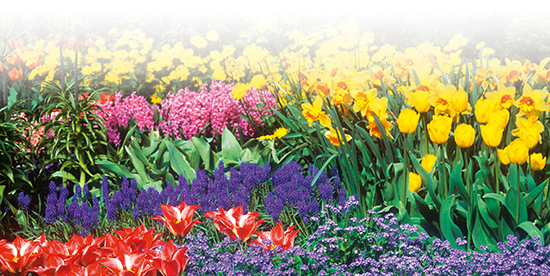Plant spring-flowering plants such as irises, crocuses, grape hyacinths or tulips in the fall.
Crocuses, snowdrops and daffodils are among the first messengers of spring, whereas dahlias, gladioli and autumn crocuses flower into late autumn. These traditional garden plants don’t require a lot of care and can easily be used to add color to a balcony or patio area if grown in pots.
The saying “the bigger, the better” really does apply to flowering bulbs, because the biggest bulbs are generally healthier and flower better.
• Buy bulbs with undamaged outer skins and firm cores. If they are sprouting or exhibit decay, throw them out.
• Store bulbs that you can’t plant immediately after purchasing in a cool, dark and airy place. Store rare and valuable varieties in the vegetable drawer of the refrigerator until they are ready to be planted.
• Plant lilies, lilies of the valley or glories of the snow (Chionodoxa) in shady areas; wood anemones (Anemone blanda) flourish in full shade. Daffodils will tolerate partial shade.
• Flowering bulbs grow best in loose, porous soil. If the soil is heavy, fill planting holes with a layer of sand about 1/2–1 inch (1–2.5 cm) deep to keep bulbs from rotting when weather is wet and cold.
• Remember that the depth for planting should always be at least twice the height of the bulb.
• Follow the instructions on the packaging of lily bulbs carefully, as there are various considerations that will determine at what depth they are planted.
• Plant bulbs at different depths to get a nice, thick flowering. This produces better results, especially in restricted spaces such as a terra-cotta pot.
• Lightly water daffodils and fritillaries after planting. Their roots will grow more quickly in moist soil.
• Plant bulbs in plastic baskets, nets or wire mesh if you plan to take them out later. They will be easier to remove and will also be protected from rodents.
• Plant the tubers or corms of summer-flowering dahlias, gladioli or crocosmia in well-loosened, aerated soil with good drainage.
Most bulbs flourish beautifully without special care. They need little watering, which makes them ideal for areas with less rainfall or for gardeners who have little time.
• Put a stake in the ground at the same time as you plant tall-growing plants, such as gladioli or dahlias, that will need support later on. If you wait until the root system is already developed before driving a stake in, you risk damaging the plant.
• In damp regions, remove tulip bulbs after their leaves have wilted and store them until the autumn in a bed of sand or sawdust in a dry, dark place.
• Snip off the flowers of bulbs after they wilt in order to save them the energy needed to form seeds. Don’t touch the leaves, however—the plant needs them to store nutrients for the winter. Keep them well watered, too, until leaves have died down.
• If possible, plant bulbs, corms and tubers in different places each year to avoid the buildup of diseases caused by fungi or bacteria.
EARLY hyacinths and daffodils HERALD THE ARRIVAL OF SPRING.
The propagation of bulbs is easy. Many form small bulbs or sprout tubers by themselves. These simply have to be detached from the parent plant and stored in a cool and sheltered place over the winter.
• Dig up bearded iris rhizomes every 2–3 years after plants have finished flowering. Divide them into several pieces and trim the leaves. Dispose of the oldest parts of the plants.
• Divide and move snowdrops immediately after flowering when they are still “in the green.”
• Divide dahlia tubers with a knife before planting in spring. Each division should have a budding sprout.
• Dig up the bulbs in the autumn and gently pull off four to six of the fleshy outer scales. Dust the wound on the parent plant with charcoal powder and replant.
• Place the scales to half their depth in a mixture of potting soil and sand. Keep them moist at room temperature by covering with plastic wrap. Don’t expose them to direct sunlight.
• When small bulbs with delicate roots form (in about 8 weeks), plant individually in small pots so that only the tips are visible and store in a dry, dark place at about 40°F (5°C). Or put the bulbs in a ziplock bag with propagating mix or fairly dry sphagnum moss and keep in the vegetable crisper in the fridge.
• Carefully plant bulbs as soon as the first delicate leaves sprout in the spring, choosing a day when it is not too cold.

A multilayered effect is created by planting low-flowering bulbs in front of high-stemmed lilies, narcissi or tulips.